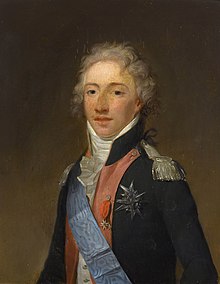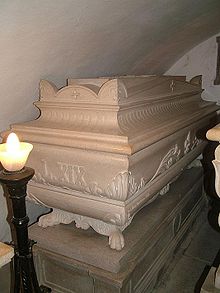Louis-Antoine de Bourbon, duc d'Angoulême
Louis Antoine d'Artois, duc d'Angoulême , as Louis XIX. Pretender to the French throne (born August 6, 1775 in Versailles , † June 3, 1844 in Gorizia ), was the eldest son of King Charles X of France and thus heir to the throne ( Dauphin ) of the French kingdom since 1824 - as the last, the carried this traditional title. He was considered the rightful French king by the legitimists .
Life
The Duke of Angoulême was the eldest son of the Count of Artois, who later became King Charles X, and his wife, Princess Marie Therese of Savoy .
Until the restoration
Angoulême followed his father into exile in Turin in 1789 , headed the emigrant army in Germany in 1792 and, after its dissolution, went to Edinburgh , then to Blankenburg am Harz and finally to Mitau , where he met his in June 1799 Cousin, the only daughter of Louis XVI. , Princess Marie Thérèse of France , wed. In 1806 he went to England, where most of the volatile before Napoleon Bourbon on Hartwell House in Aylesbury at Oxford an asylum had found.
When the Allies marched into France in 1814, he appeared on February 2 at the British-Spanish headquarters in Saint-Jean-de-Luz and gathered many supporters of legitimate royalty around him. Under the protection of the English army, he entered Bordeaux on March 12 , proclaimed Louis XVIII. as king and proclaimed amnesty, freedom of religion and remedy of all just complaints. After the establishment of the Bourbon monarchy, he was made Admiral of France and Colonel général des carabiniers and, after Napoleon's return in 1815, Lieutenant-général .
He moved south with line troops and national guards against Napoleon, gained some advantages over the Bonapartists at Montélimar and Loriol, but was pushed back at Saint-Jacques on April 6, abandoned by his troops and captured by Grouchy at Pont-Saint-Esprit . Released six days on the orders of Napoleon, he went to Madrid and prepared an incursion into France on the French border.
His uncle accused him of being responsible for Napoleon's rule of the Hundred Days . He only forgave him in 1815 after Napoleon's second downfall and his exile on the island of Saint Helena , when he was reinstated as King of France by the Congress of Vienna .
After the Battle of Waterloo , Angoulême entered Bordeaux and Toulouse.
French invasion of Spain
In 1823, on behalf of his uncle and the Holy Alliance, he was given supreme command of the French invading army destined to suppress the Spanish Revolution. The Holy Alliance was a loose alliance of European rulers to maintain the conservative monarchy, if necessary by force of arms. Outwardly, the Holy Alliance set other goals, allegedly the states had committed themselves to align their policies with the Christian commandments of peace, justice and love and to provide mutual assistance. Members included Tsar Alexander I of Russia , who had drafted the plan for this alliance, as well as Emperor Franz I of Austria , King Friedrich Wilhelm III. of Prussia and of course King Louis XVIII. from France.
The Duke of Angoulême should restore the absolutist royal power in Spain and eradicate the liberal forces.
During the absence of Ferdinand VII , enforced by Napoleon , the Cortes of Cadiz enacted a liberal constitution in Spain in 1812. Ferdinand VII immediately repealed this constitution when he returned to Spain in 1814.
After a pronunciamiento and unrest in Madrid, Ferdinand VII felt compelled in March 1820 to reinstate the Cádiz Constitution from 1812. Duke Louis Antoine of Angoulême crossed the Bidasoa on April 6, 1823 and entered Madrid on May 24, 1823 without significant resistance. Not until Cádiz did he have to storm the Trocadero by force on August 30, 1823 , for which he was appointed Prince of Trocadero. Angoulême defeated the liberals and helped King Ferdinand VII in 1823, as between 1814 and 1820, to rule in an absolutist way and without any restriction by a constitution or a parliament. The Duke of Angoulême tried in vain to counteract the acts of violence of the vengeful royalists; even his proclamation of Andujar (August 8th) and his wish for a general amnesty to be issued were ignored.
dauphin
With the death of Louis XVIII. In 1824 his father, the Count of Artois, became the new King of France as Charles X. Angoulême henceforth held the title of Dauphin. In 1830 the July Revolution broke out, in the course of which Charles X had to abdicate. The Dauphin, now known as Ludwig XIX. should have succeeded, also renounced the throne - after he was theoretically the rightful King of France for twenty minutes - in favor of his nephew Henri d'Artois , the son of his younger brother Charles Ferdinand , Duke of Berry, who was murdered in 1820 . The hope of Charles X and the previous Dauphin to possibly save the throne for their own dynasty was not fulfilled, however, as Louis-Philippe I from the House of Orléans followed in France .
Louis Antoine followed the abdicated king into exile in Holyrood , in 1832 in Prague and in 1836 in Gorizia, where he lived with his wife in complete seclusion under the title of Count of Marnes and died on June 3, 1844 without leaving any descendants. He was buried in the Kostanjevica Monastery in Nova Gorica in present-day Slovenia.
ancestors
| Louis XV King of France (1710–1774) | |||||||||||||
| Ludwig Dauphin of France (1729–1765) | |||||||||||||
| Maria Leszczyńska Queen of France and Princess of Poland (1703–1768) | |||||||||||||
| Charles X. King of France (1757–1836) | |||||||||||||
| August III. King of Poland, Kft. Of Saxony (1696–1763) | |||||||||||||
| Maria Josepha of Saxony (1731–1767) | |||||||||||||
| Maria Josepha of Austria (1699–1757) | |||||||||||||
| Louis-Antoine de Bourbon | |||||||||||||
| Charles Emanuel III. Duke of Savoy and King of Sardinia-Piedmont. (1701-1773) | |||||||||||||
| Viktor Amadeus III. King of Sardinia-Piedmont and Duke of Savoy. (1726-1796) | |||||||||||||
| Polyxena of Hessen-Rotenburg (1706–1735) | |||||||||||||
| Maria Theresa of Savoy (1756–1805) | |||||||||||||
| Philip V King of Spain (1683–1746) | |||||||||||||
| Maria Antonia of Spain (1729–1785) | |||||||||||||
| Elisabetta Farnese (Queen of Spain 1692–1766) | |||||||||||||
literature
- Jaromir Hirtenfeld : The military Maria Theresa order and its members . Vienna 1857, pp. 1325-1329.
Web links
| predecessor | Office | successor |
|---|---|---|
| King Charles X of France |
 Head of the House of Bourbon, legitimist pretender to the throne of France 1836–1844 |
Henri Charles d'Artois |
| personal data | |
|---|---|
| SURNAME | Angoulême, Louis-Antoine de Bourbon, duc d ' |
| ALTERNATIVE NAMES | Bourbone, Louis-Antoine; Louis XIX .; Artois, Louis-Antoine d ' |
| BRIEF DESCRIPTION | eldest son of King Charles X of France |
| DATE OF BIRTH | August 6, 1775 |
| PLACE OF BIRTH | Versailles |
| DATE OF DEATH | June 3, 1844 |
| Place of death | Gorizia |



